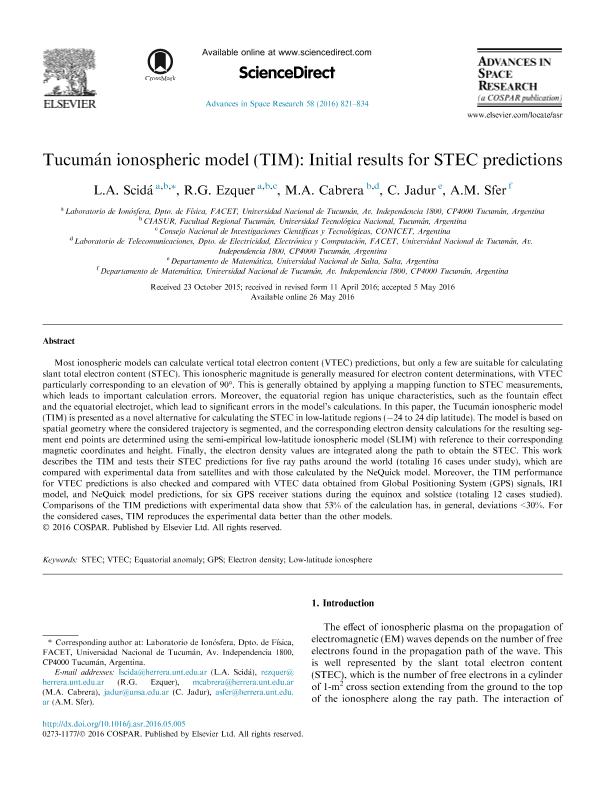Artículo
Tucumán ionospheric model (TIM): Initial results for STEC predictions
Scida, Luis Alberto; Ezquer, Rodolfo Gerardo ; Cabrera, Miguel Angel; Jadur, Camilo Alberto; Sfer, Ana María
; Cabrera, Miguel Angel; Jadur, Camilo Alberto; Sfer, Ana María
 ; Cabrera, Miguel Angel; Jadur, Camilo Alberto; Sfer, Ana María
; Cabrera, Miguel Angel; Jadur, Camilo Alberto; Sfer, Ana María
Fecha de publicación:
09/2016
Editorial:
Elsevier
Revista:
Advances in Space Research
ISSN:
0273-1177
Idioma:
Inglés
Tipo de recurso:
Artículo publicado
Clasificación temática:
Resumen
Most ionospheric models can calculate vertical total electron content (VTEC) predictions, but only a few are suitable for calculating slant total electron content (STEC). This ionospheric magnitude is generally measured for electron content determinations, with VTEC particularly corresponding to an elevation of 90°. This is generally obtained by applying a mapping function to STEC measurements, which leads to important calculation errors. Moreover, the equatorial region has unique characteristics, such as the fountain effect and the equatorial electrojet, which lead to significant errors in the model's calculations. In this paper, the Tucumán ionospheric model (TIM) is presented as a novel alternative for calculating the STEC in low-latitude regions (−24 to 24 dip latitude). The model is based on spatial geometry where the considered trajectory is segmented, and the corresponding electron density calculations for the resulting segment end points are determined using the semi-empirical low-latitude ionospheric model (SLIM) with reference to their corresponding magnetic coordinates and height. Finally, the electron density values are integrated along the path to obtain the STEC. This work describes the TIM and tests their STEC predictions for five ray paths around the world (totaling 16 cases under study), which are compared with experimental data from satellites and with those calculated by the NeQuick model. Moreover, the TIM performance for VTEC predictions is also checked and compared with VTEC data obtained from Global Positioning System (GPS) signals, IRI model, and NeQuick model predictions, for six GPS receiver stations during the equinox and solstice (totaling 12 cases studied). Comparisons of the TIM predictions with experimental data show that 53% of the calculation has, in general, deviations <30%. For the considered cases, TIM reproduces the experimental data better than the other models.
Palabras clave:
Electron Density
,
Equatorial Anomaly
,
Gps
,
Low-Latitude Ionosphere
,
Stec
,
Vtec
Archivos asociados
Licencia
Identificadores
Colecciones
Articulos(CCT - NOA SUR)
Articulos de CTRO.CIENTIFICO TECNOL.CONICET - NOA SUR
Articulos de CTRO.CIENTIFICO TECNOL.CONICET - NOA SUR
Citación
Scida, Luis Alberto; Ezquer, Rodolfo Gerardo; Cabrera, Miguel Angel; Jadur, Camilo Alberto; Sfer, Ana María; Tucumán ionospheric model (TIM): Initial results for STEC predictions; Elsevier; Advances in Space Research; 58; 6; 9-2016; 821-834
Compartir
Altmétricas



